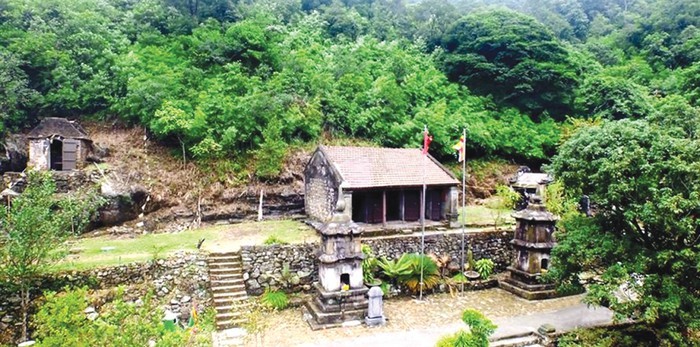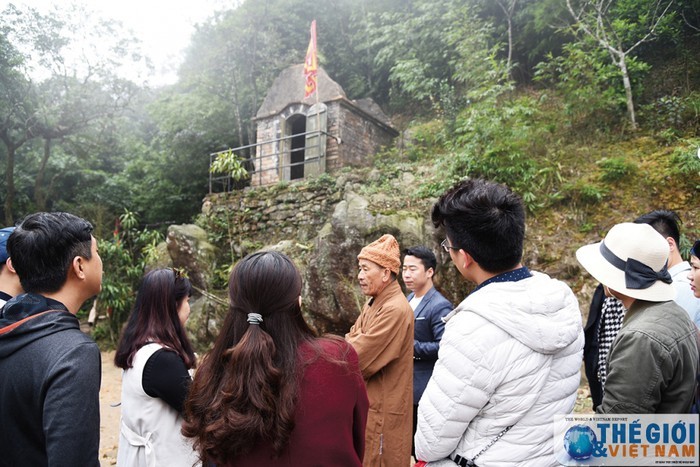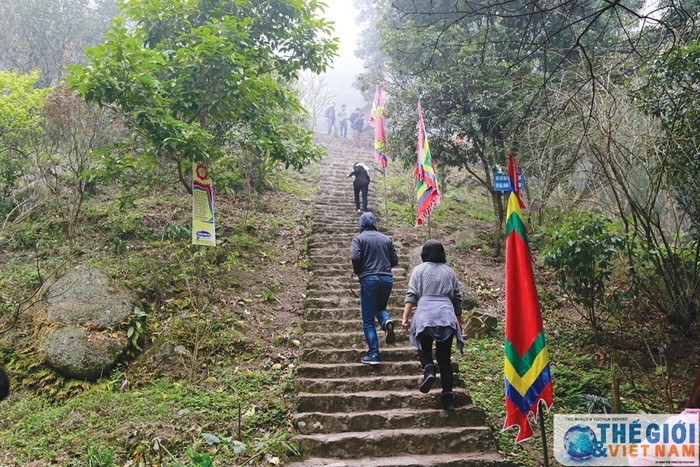(VOVWORLD) - Quang Ninh province is best known for its natural landscape, notably the world natural heritage site Ha Long Bay, and also dubbed as the Buddha Land in Vietnam. The Ngoa Van pagoda complex, a special national relic site, is considered the heart of Vietnam’s indigenous Truc Lam Yen Tu Zen Buddhist sect.
 The original Ngoa Van pagoda in the complex (Photo: baoquocte.vn) The original Ngoa Van pagoda in the complex (Photo: baoquocte.vn) |
Ngoa Van – a large pagoda complex at the top of Bao Dai (also called Vay Rong) Mountain - is one of 4 pagodas belonging to the Tran Dynasty. The original Ngoa Van pagoda, the highest building in the site, was where King Tran Nhan Tong practiced Buddhism during the final years of his life and established the Truc Lam Yen Tu Zen sect in the early 14th century.
Ngoa Van pagoda means "Pagoda on the Clouds". At 500 meters above sea level, the pagoda has beautiful views, as it is seen resting on the cloud covered Ngoa Van Mountain Peak, with two mountain ranges to either side, looking over into a valley with the Cam River curving through. Visitors wade through several brooks, climb slopes, and hike along the winding mountain road in the forest, leading them to an arcade made of intertwining bamboo trees.
 Visitors listen to story about King-Monk Tran Nhan Tong at Ngoa Van pagoda. (Photo: baoquocte.vn) Visitors listen to story about King-Monk Tran Nhan Tong at Ngoa Van pagoda. (Photo: baoquocte.vn) |
Monk Thich Thanh Tien, Ngoa Van pagoda’s Abbot, said: “According to historical records and research, King Monk Tran Nhan Tong lived and practiced Buddhism in Ngoa Van pagoda before he died in 1308. The pagoda is treasured as the last memory in the King’s religious life.”
Venerable Thich Thanh Quyet, Chairman of the Executive Board of the Buddhist Sangha in Quang Ninh province, told VOV: “This is the place where King Tran Nhan Tong’s ideology of patriotic and humane Buddhism was born and nurtured.”
In August 1299, King Tran Nhan Tong retired to lead a religious life as a hermit in the Yen Tu mountains. He founded the Truc Lam Zen sect, after which he traveled to nearby villages to provide health services to the poor and encourage people to do good deeds. After more than 700 years of development, the Truc Lam Zen sect has promoted the spirit embracing life and of living a religious life and fulfilling a citizen’s responsibility for national construction and development. In 1307, he climbed back the mountain to continue his monastic existence at Ngoa Van pagoda where he then attained Nirvana in late 1308.
Trinh Van Anh, lecturer of the University of Social Sciences and Humanities and member of the archeological team of the Ngoa Van pagoda, said: “The younger generations are responsible for promoting the Buddhist values of Ngoa Van pagoda. Visitors to this place can acquire both historical knowledge and the King’s Buddhist ideology.”
 Pilgrims climb the mountain to Ngoa Van pagoda. (Photo: baoquocte.vn) Pilgrims climb the mountain to Ngoa Van pagoda. (Photo: baoquocte.vn) |
The Ngoa Van Spring Festival is held in Ngoa Van Pagoda every year from January 9th till the end of March in the lunar calendar to pay tribute to King-Monk Tran Nhan Tong, reflecting the Vietnamese spirit of “remembering the source of the water we drink”, and popularizing the thoughts of the Truc Lam Zen sect.
Do Thanh Le, a tourist from Hai Phong city, said: “A trip to Ngoa Van pagoda has inspired patriotism in me and the will to live a better life. This place embodies great historical values and Vietnamese traditions.”
Besides two stone trails, a cable car has been installed to facilitate quick travel to Ngoa Van pagoda. A pilgrimage route connecting Ngoa Van pagoda, the Yen Tu relic site, and the Tran Dynasty historical complex in Dong Trieu district has been opened to the public.